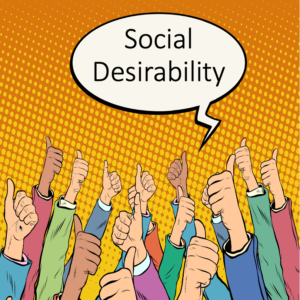By Dr. Ken Broda Bahm:

Imagine you’re currently a citizen of the Russian Federation. The telephone rings, and the person on the other end of the line identifies themselves as a public opinion researcher, and they’re conducting a poll. “How do you feel about your country’s current ‘special military operation’ in Ukraine?” Well, given that the Russian government is quite authoritarian, given that thousands of Russian citizens are currently being arrested and prosecuted for protesting the war, and given that the Russian President has recently committed himself to “cleansing” the country of those insufficiently loyal to the state, how do you answer? Well, if you’re with the strong majority in recent polls, you will say you support it. And, doubtless, some of that support is genuine, but inevitably, the circumstances are putting a large thumb on the scale in favor of what might seem like the desired or expected response.
This is an extreme example of a common threat to accurate polling and accurate questioning generally: social desirability bias. It is the tendency to give the answer that is situationally perceived as being the “right” answer, as opposed to giving an honest answer. It applies in the courtroom most obviously during voir dire. When the black-robed judge on a raised dais next to an American flag gives you a stern look asks you if you can follow the law and set aside your bias, the perceived correct answer is, “Yes, I can.” For lawyers, the pull of the expected answer can be useful at times — for example, when you’re trying to lead a juror into or out of a cause challenge. But when you’re actually trying to learn about their attitudes relating to your case, any question that signals a correct answer will strongly limit the utility of your voir dire. In this post, I’ll share six tips for avoiding social desirability bias in voir dire.
1. Have Lawyers Ask Rather than Judges
Potential jurors are more likely to shade their answers in the socially desirable direction when being asked by judges. One study (Jones, 1987) demonstrated that when potential jurors are being questioned by a judge rather than a lawyer, they’re almost twice as likely to give that judge an answer that is different from what they gave in a pretest. Simply put, judges are more intimidating. So, where you have that ability, take advantage of attorney-conducted voir dire in order to get more honest responses.
2. Set a Context
Panelists are likely to read the room, and the overly formal courtroom atmosphere might tell them that there is a “correct” answer. So start voir dire by trying to set a different context:
This part of the process is about sharing what you truly think — there are no right or wrong answers, and there is no need to agree with me, or with opposing counsel, or with the judge. This is a special time when the focus is purely on you, and on what actually and honestly feel.
3. Make It A Question, Not a Statement
Don’t turn a statement into a question by adding, “Do you agree that…” or “How many of you think that…” at the start of it. A leading question is good strategy in cross-examination, but not when assessing attitudes in voir dire. Any statement embedded in your question signals the right answer. That can be effective in making or rehabilitating a cause challenge, but it doesn’t work for learning true attitudes.
4. Make the Question Open-Ended
An open-ended question will always be more educational to you than a “Can you be fair” style question. Asking them a question like, “What do you think about…” a case-relevant issue is going to yield a more honest and unique response. When they answer in their own words, you will learn what matters to them, and also learn how articulate they are, which will tell you who your leaders are likely to be.
5. Give Options
After asking open-ended questions, you will often want some way to divide the group. One way to do that is to give them two or more options, in the style of asking them “How many of you are closer to [attitude one] and how many are closer to [attitude two]?” If you phrase it so that both attitudes sound reasonable and fair, you avoid signaling to the group that you are pushing them toward one option or the other.
6. Frame It as Agreement with Another Juror
When you do ask for their reactions to a specific attitude, it helps if that attitude comes not from you but from another potential juror. In other words, after asking Mr. Smith an individual open-ended question, you can turn the answer into a group question by asking, “How many of you agree with Mr. Smith?” That signals that it is okay to express that opinion, because one member of the panel just did. You can also flip it by asking who disagrees. But working with the panelists’ own words helps to send the message that you are interested in what they think, and not just trying to prime them toward any specific views.
One feature that social desirability bias shares with other cognitive biases is that it is generally unconscious. People won’t typically say to themselves, “I will just give the answer they seem to want.” Instead, the expected answer will, under the circumstances, seem more like the real and honest answer. That is the reason why in voir dire, as much as you are able to, you need to create a context for a free, open, and honest discussion of attitudes.
____________________
Other Posts on Social Desirability Bias:
- Take It Seriously: Potential Jurors Cannot Self-Diagnose Their Bias
- In Voir Dire, Create a Context for Candor
- Get Beyond “Can You Be Fair?”